Zoom
Trash

GitHub - jwasham/coding interview university. Learn X in Y Minutes: Scenic Programming Language Tours. VisuAlgo - visualising data structures and algorithms through animation. Vamonos: Dynamic algorithm visualization in the browser. Vamonos is a library for generating browser-based visualizations of algorithms & data structures.
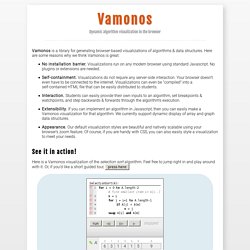
Here are some reasons why we think Vamonos is great: No installation barrier. Visualizations run on any modern browser using standard Javascript. No plugins or extensions are needed. Self-containment. Here is a Vamonos visualization of the selection sort algorithm. We have developed pre-made visualizations of many common algorithms. The latest version of Vamonos is v2.1.0. Past releases, source code, and everything else is available on our github project page. Educators wishing to write their own visualizations in Vamonos should start with our User’s Guide: More detailed information can be found in our API reference: API Reference Vamonos is developed in the EECS department of Oregon State University. The name “Vamonos” doesn’t really have to be an acronym, but if it were, its expansion would be Visualizing Algorithms from Montana and Oregon State.
The Vamonos project team: Algorithms - Stanford University. Networking for Web Developers. Software Testing Methodologies. Software Testing How to Make Software Fail Intermediate Approx. 1 month Assumes 6hr/wk (work at your own pace) Join 67,785 Students View Trailer Course Summary When writing software, destruction can be just as valuable as creation.
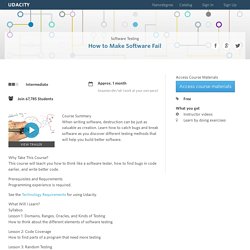
Introduction to FP with Haskell. Broadly speaking, functional programming is a style of programming in which the primary method of computation is the application of functions to arguments.
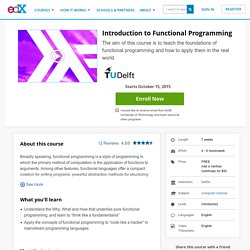
Among other features, functional languages offer a compact notation for writing programs, powerful abstraction methods for structuring programs, and a simple mathematical basis that supports reasoning about programs. Functional languages represent the leading edge of programming language design, and the primary setting in which new programming concepts are introduced and studied. All contemporary programming languages such as Hack/PHP, C#, Visual Basic, F#, C++, JavaScript, Python, Ruby, Java, Scala, Clojure, Groovy, Racket, … support higher-order programming via the concept of closures or lambda expressions. Functional Programming Principles in Scala. About this course: Functional programming is becoming increasingly widespread in industry.
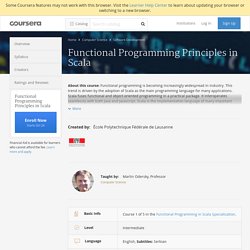
This trend is driven by the adoption of Scala as the main programming language for many applications. Scala fuses functional and object-oriented programming in a practical package. It interoperates seamlessly with both Java and Javascript. Scala is the implementation language of many important frameworks, including Apache Spark, Kafka, and Akka. It provides the core infrastructure for sites such as Twitter, Tumblr and also Coursera. Functional Program Design in Scala. About this course: In this course you will learn how to apply the functional programming style in the design of larger applications.

You'll get to know important new functional programming concepts, from lazy evaluation to structuring your libraries using monads. We'll work on larger and more involved examples, from state space exploration to random testing to discrete circuit simulators. You’ll also learn some best practices on how to write good Scala code in the real world. Parallel programming with Scala. About this course: With every smartphone and computer now boasting multiple processors, the use of functional ideas to facilitate parallel programming is becoming increasingly widespread.
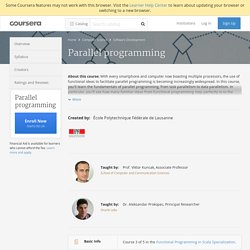
In this course, you'll learn the fundamentals of parallel programming, from task parallelism to data parallelism. In particular, you'll see how many familiar ideas from functional programming map perfectly to to the data parallel paradigm. We'll start the nuts and bolts how to effectively parallelize familiar collections operations, and we'll build up to parallel collections, a production-ready data parallel collections library available in the Scala standard library. Throughout, we'll apply these concepts through several hands-on examples that analyze real-world data, such as popular algorithms like k-means clustering. Good Program Design. Programming Languages: Building A Web Browser. When does the course begin?
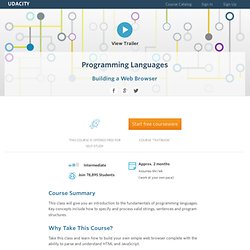
This class is self paced. You can begin whenever you like and then follow your own pace. It’s a good idea to set goals for yourself to make sure you stick with the course. Intro to Theoretical CS (Algo Complexity) When does the course begin?

This class is self paced. You can begin whenever you like and then follow your own pace. It’s a good idea to set goals for yourself to make sure you stick with the course. How long will the course be available? This class will always be available! Software Development Process. Software Engineering: Concepts and Practice Course Creator and Instructor Course Developer and Teaching Assistant Sarah SpikesCourse Developer, Lead Teaching Assistant Overview This course provides an in-depth study of the process of developing software systems, including the use of software processes in actual product development, techniques used to ensure quality of the software products and maintenance tasks performed as software evolves.
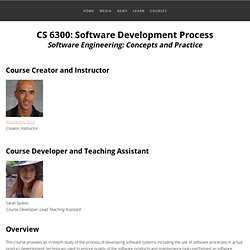
Prerequisites Students should be familiar with at least one programming language (Java strongly preferred) and with basic software engineering concepts. If you answer "no" to any of the following questions, it may be beneficial to refresh your knowledge of this material prior to taking CS 6300: 1. To gain an understanding of a typical CS 6300 project, please read the description of our Mobile Android App for Managing TODO Lists assignment.
Grading You will receive grades through T-Square. You will submit your projects directly through the Udacity site. Software Architecture and Design. Course Creators and Instructors Overview Software Architecture and Design will provide students with the principles and concepts involved in the analysis and design of large software systems.

The learning objectives for the course are the following: Understand and apply object-oriented design techniquesDevelop and evaluate software architecturesSelect and use appropriate architectural stylesSelect and use appropriate software design patternsExpress the specifications and design of an application using UMLSpecify parts of the design using a formal design language (OCL)